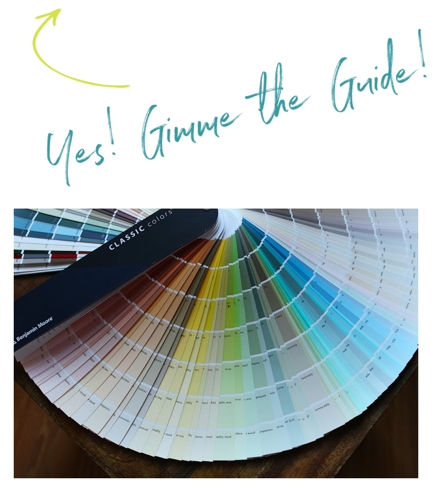Dear Laurel,
While reading this informative article (several times), I became entranced by the window treatments, especially the curtain and drapery hardware. Would you please consider doing a blog post on the hardware required for a professional-looking installation?
Also, what is the difference between curtains and draperies? And, is there a difference between draperies and drapes?
I appreciate all you do Laurel.
Emilia
Thank you, Emilia.
Yes, I am in the process of moving, and yes, the renovation is starting this Monday!
Some of the information about curtain and drapery hardware is in this old post about window treatments.
However, I would like to explore this important topic more deeply. There is even more information in the 333 Decorating Rules & Tips, you need to Know guide.
And, of course, we will also go over some things to avoid doing.
Re: the difference between draperies, drapes, and curtains.
Thanks, great questions. As far as I’m concerned, the terms are interchangeable. Most people think of curtains as being more casual and lighter in weight.
So, whether you say curtains, drapes, or draperies, let’s dive into the basics of the hardware that holds the drapes up.
Early in my career, in the mid to late 90s, I did wooden rods for clients. However, I began seeing wrought iron rods done by all of my favorite design idols, like Victoria Hagan.
Great, because:
- I loved, and still do the wrought iron rods.
- In addition, fine wooden drapery rods were hideously expensive. I once joked with a client that she had a choice of a baby grand piano or drapery rods. haha
Therefore, I will only stick with iron rods for this post about drapery hardware.
Incidentally, I didn’t know until several years ago, but what is commonly referred to as “wrought iron” is actually steel. I learned that years ago from a lovely company, By Hammer By Hand, who made all of my custom wrought iron (steel) rods and more!
They were local to me when I lived in northern Westchester County, NY. However, they ship all over the country. Plus, their prices are very reasonable for custom work.
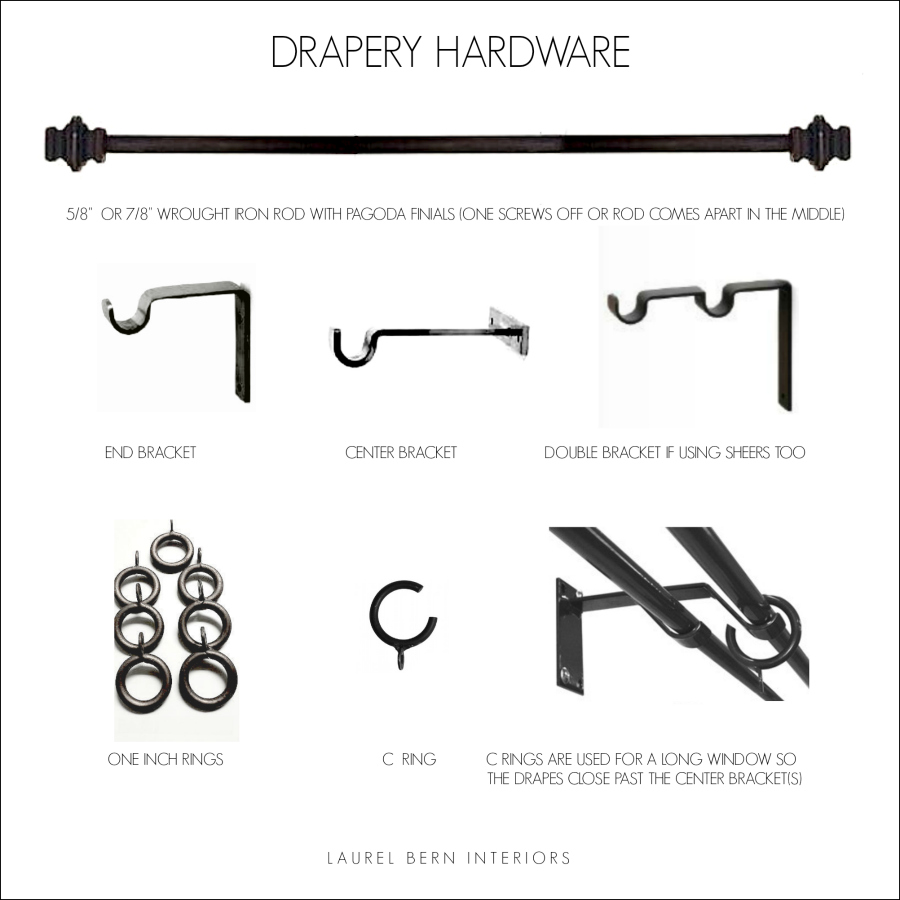
Above is pretty much all I’ve ever used in the way of drapery hardware.
This consists of a rod and a straight pipe made of metal and then painted either in a soft black or antique gold.
- Brackets to hold up the rod
- Decorative finials for the ends
- Rings (with hooks) to hold up the draperies or curtains.
Let’s Begin our Drapery Hardware topic with Curtain Rods.
The rods you will most commonly find are 1″, 3/4″, or 5/8″ in diameter. The rods I did were either 3/4″ or 5/8″. That way, I could easily use a 1″ (opening) ring.
What about the telescoping rods? (adjustable rods) Some of you may already know that I am not a fan, and here’s why:
Back in 1999, I had a client on a strict budget. So, we did the adjustable rods. Because one end is wider than the other, we spent two hours trying to get the curtains to hang straight.(ish) After that nightmare evening, I said, “Never again.”
Still, it isn’t the end of the world if that’s all your budget will allow. Please understand that everything I’m recommending is optimal situations.
In addition, an uneven hanging issue can occur with custom rods, too. The possible reasons for this unfortunate result are because of the following:
- floor is uneven
- window is crooked
- ceiling is crooked
- Everything is crooked and uneven.
I have a hard and fast rule in interior design, especially with curtain rods.
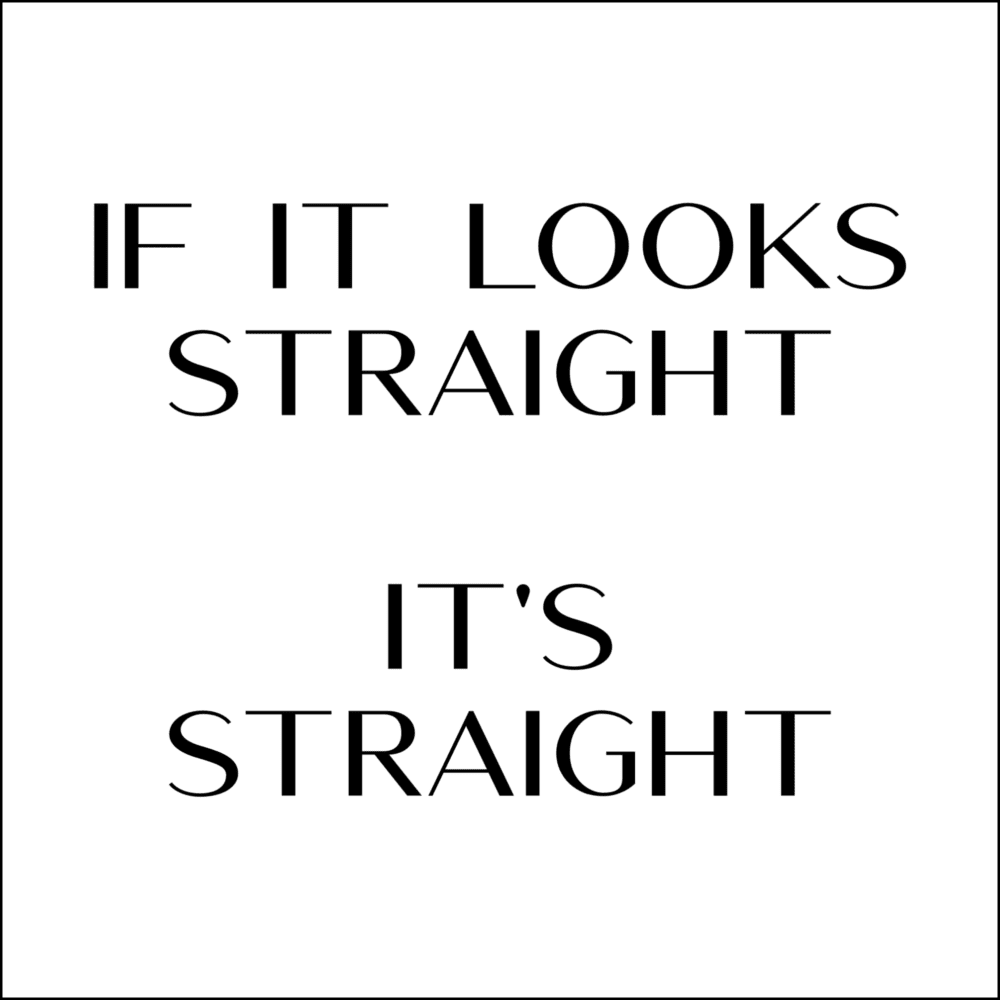
I recommend putting that one up last if there needs to be a center bracket.
Hang the rod without the center bracket and then have the installer hold the center bracket until the rod is no longer sagging but also not arching upwards. He will then put a pencil mark in the holes where the screws are going, and that is where he’ll drill his holes.
What if the rod is still sagging, and you can’t drill a hole because it is too close to the one already there? OR, the hole will show?
Ahhh… well, you DO have a problem. If it’s for a client, here’s what I suggest.
First, go to where they keep their booze and pour yourself a stiff shot (or two) of whiskey. ;] ;] ;]
Sure, go ahead and laugh. However, everything I’m writing about has happened to me, and sometimes on more than one occasion. I can guarantee it’s stressful as hell.
Okay, this is one of my favorite tricks; if you don’t want to or can’t make another hole, you can put a small piece of foam or something of that nature between the rod and the bracket it’s sitting on. This will raise it up some, and it won’t be noticeable. Nothing worse than a drapery rod that’s sagging in the middle, AND also supported by a bracket.
Okay, what if holes in the wall are showing, anyway.
Please try not to do that. I worked with one installer on several jobs and lickety-split; he had put up the brackets before I could stand back and say, “Doug, ummm, the rod is crooked.”
Naturally, I got tired of this (and my clients complaining) and, thus, replaced him.
However, even with the most careful installer, mistakes are very easy to make. This is why your clients MUST go for a protracted, deluxe spa treatment while you’re putting up the drapery hardware and window treatments. ;]
Really, unless they are the super chill type, they should not be home. It is for the same reason that you can’t be in the operating room if your child is having surgery performed.
So, now you have holes in your client’s walls.
After you’ve drunk the whiskey, you need to pray that somewhere, in the garage, basement, attic, closet– SOMEWHERE lives a left-over can of paint to match the current wall color. Your installer should always carry spackle with him in his tool kit. Have him fill the hole ASAP. Go find a hair dryer. Stand there like a nerd blowing the spackle dry. Dab the paint on very carefully.
Do not get paint on the window treatment. lol
Definitely, do not knock the paint can over. (Make sure the dog is nowhere nearby, as well.)
Carefully put the lid back on– tightly and put the can and hair dryer back where you found them.
End of story.
Hopefully.
Getting back to the rods. Yes, we are still only on the rods
If the expanse of the wall is more than eight feet, I recommend using the 3/4″ rod with a center bracket.
What matters is how the bracket gets attached to the wall. Of course, optimally, the rods will be screwed into a piece of wood known as a stud. Right? Well, if it’s a home built in the last 30 years or so, good luck with that one.
My experience is that new homes are typically made primarily out of cardboard and glue. This is not conducive to holding a metal rod with a ten-pound curtain hanging from it, along with an eight-year-old who’s using the curtain as a fortress.
Butterfly screws are your best friend, and while trickier to install will usually do the job.
In the 20 years I was taking clients, I went to every window treatment installation. And, whenever it was finished, it was an incredible relief! There are so many things that can go wrong!
If you’re a designer and you find an installer who does a great job, I would treat him (or her) like gold. They are not easy to find.
I’ve never gotten into anything fancy regarding twists and other unusual shapes for the decorative curtain rods. Just a plain pipe.
However, about 20 years ago, I began to see a lot of rods that had a return back into the wall. In other words, the rods curve back on themselves and go straight into the wall. The most sleek ones look like they are growing straight out of the wall. But, of course, they are well anchored into the wall, just as the straight pipe is.
The pipe can either be curved or at a sharp right angle, but it’s most commonly just a curve. These are called either return rods or French return rods.
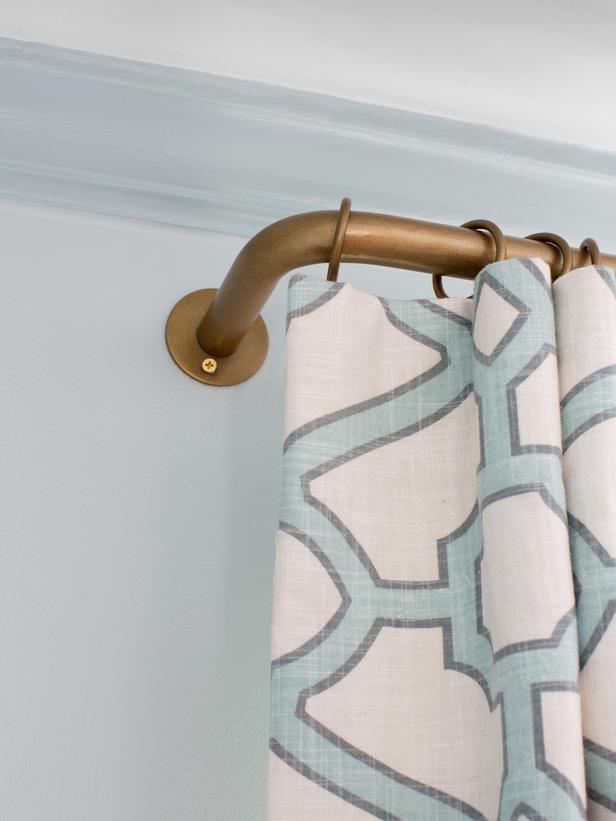
If the rod is a straight rod, you usually need a finial unless you are doing a rod with a self-cap.
You rarely see it, so I wouldn’t get too hung up about that detail.
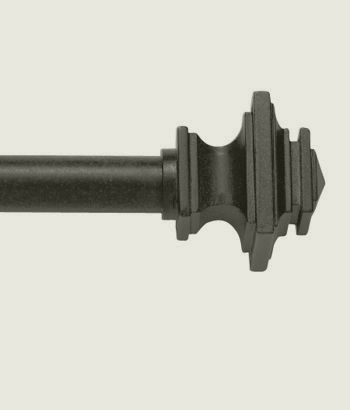
However, above is my favorite finial, which we fondly called the pagoda finial. Of course, you can do a plain ball, an acorn, whatever you like.
Drapery Hardware: Brackets
Brackets, of course are the supports that hold up the rod. And, there are many, many kinds to choose from. Generally, the simpler, the better. You can read more about them in this post. There are so many to choose from, but the ones I generally did are in the graphic above.
More about brackets later on.
Drapery Hardware: Rings
Okay, a basic ring should have a loop on one end. Then, you will need a steel drapery pin that attaches to the drape and hooks into the loop.
The pin must be placed so you cannot see the loop when the drapery is hanging. This takes a little practice, but eventually, figuring out the placement is not difficult.
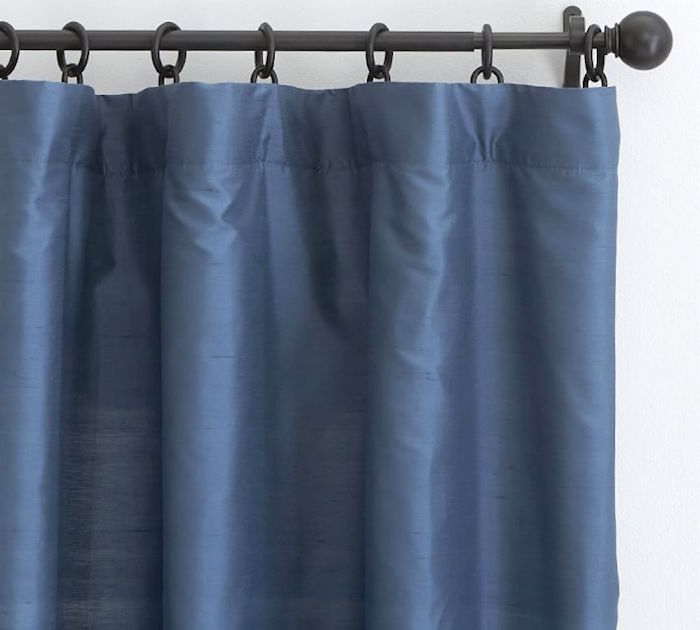
I love Pottery Barn. I like their ready-made curtains like this lovely silk dupioni. But, those rings! The bottom loop should not be seen unless absolutely necessary because that’s the length you need. Imagine if it was pulled out all of the way. This isn’t the best solution. The pin should’ve been placed about a 1/2″ lower.
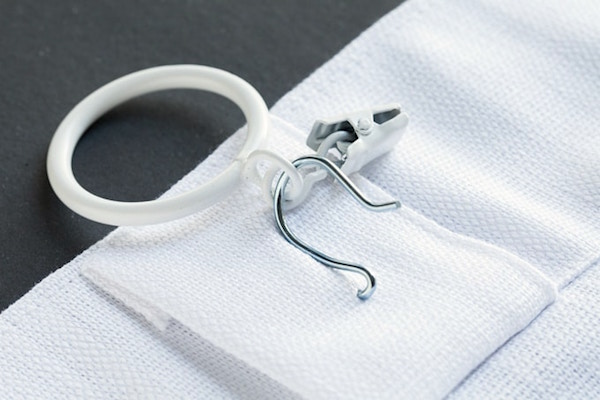
I have never understood the ring with a clip. Who wants to see an ugly clip? I guess it’s for people who can’t be bothered to use a drapery pin.
The one above has a loop and a clip. I guess no one will see the clip, in this case, since they are using a pin. Yes, the pin is correct.
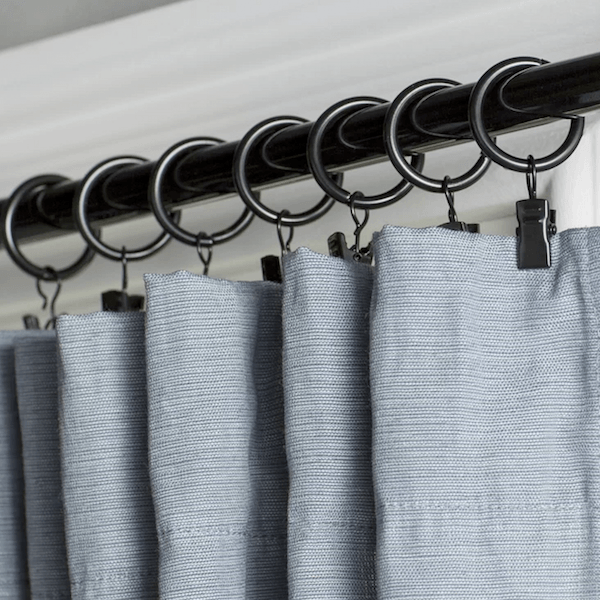
See what I mean? It’s like beetles are holding up the curtains. So bad.

Above another exquisite room by Suzanne Kasler. See, you hardly even notice the bracket in the center of the rod. The draperies are beautiful and cover up the loop at the bottom of the ring.
This image should go in the post about grown-up twin beds, right?
For more about rings and clips, please check out this post with great information.
Frequently Asked Drapery Hardware + questions and problems.
Well, why do you need rings at all, Laurel?
That’s a great question.
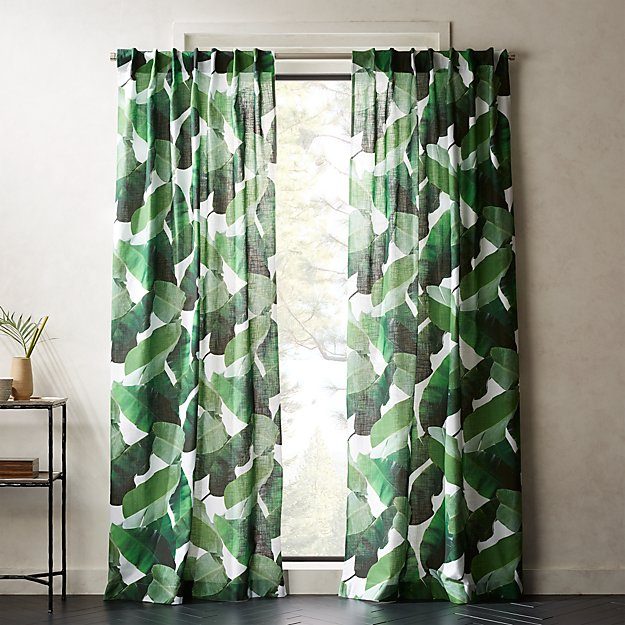
First of all, THIS looks bloody dumb, IMO.
It is very strange to have the drape covering a decorative rod. I never saw this done until maybe 15 years ago. In addition, please note that they hung the drape below the window casing. They did it because of the ready-made length. They always make an 84″ length; the next length is 96″. Someone should get wise and make a 90″ length.
Alas, I think it started when all the ready-made curtains became popular.
Ready-mades are a great solution when one can’t afford custom. But, rings are just one more expense. Perhaps, the likes of Pottery Barn and West Elm realize that they can sell more window treatments if they don’t also have to sell them the rings, as well.
But, have you ever tried to scoot fabric along a metal rod?
If you have, you will know exactly what I’m talking about. It’s very similar to trying to squeeze into your tightest jeans on January 2nd.
But worse.
Every time you try to open and close the drapes, you will be met with the most resistance you’ve ever known since your kids were five, and you said that it was too close to dinner time to get ice cream while dragging them out of the amusement park.
And, that goes for tab-top curtains too.
Sooooo, if you know that you will never open and close the curtains, then I guess you could go without rings. But, it is not a professional look. It is fine to disagree with me. But show me when Suzanne Kasler, Bunny Williams, or Victoria Hagan does drapes gathered around the drapery rod.
They don’t ever do that.
Still… if it’s temporary, you’re broke, and you need something cheap, then, of course, it’s absolutely fine to do everything I’m saying not to do.
In fact, I’ve considered doing something like that for my new rental. Although, I have plenty of rings left over that are now in my storage closet.
Speaking of rings, another trick to make the drapes open and close super easily is to rub a little soap along the top of the rod. You can also use silicone, but never spray directly on the rod, and wipe it on outside. I never tried it, but a little beeswax from a candle would most likely work, too.
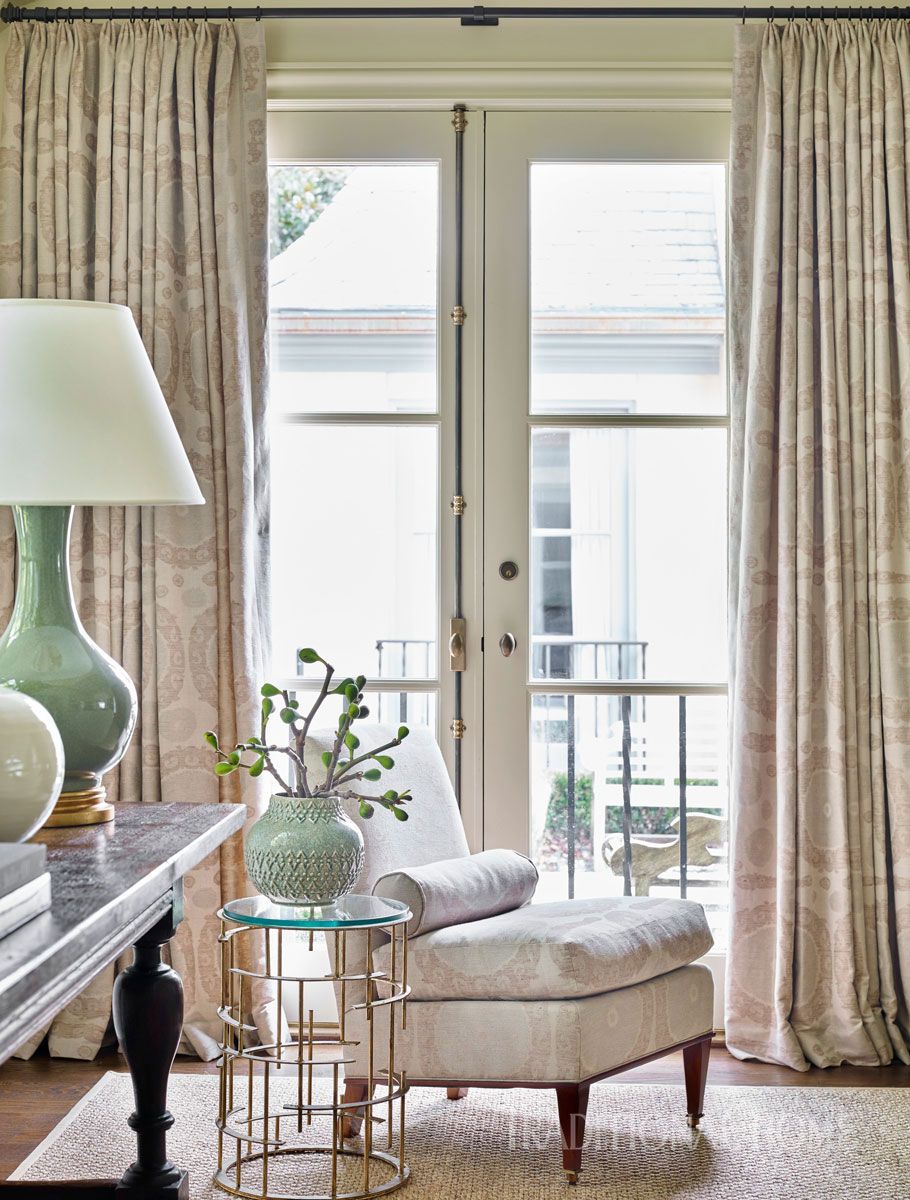
via Traditional Home (no longer being published) ;[
Another beauty from Suzanne Kasler. Exquisite. That looks to be either a 3/4 or one-inch rod. The draperies are full. The header is covering the loop on the ring, and they are breaking about an inch or two on the floor.
Laurel, aren’t they worried about the draperies getting dirty?
Not at all. They are too busy worrying about their kids getting into Princeton, Harvard, Yale…
However, if you need/want to save money and have a working curtain without rings, I think a grommet curtain is fine for a casual look.
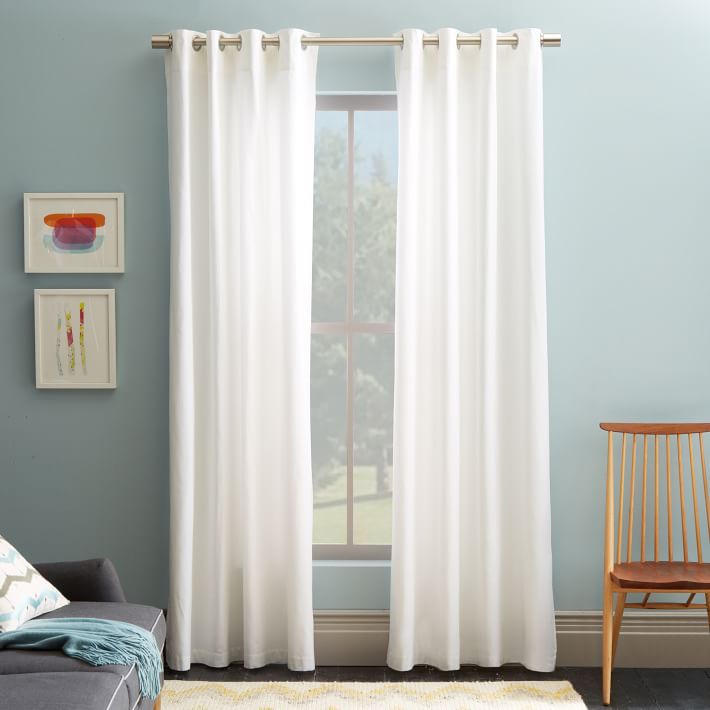
This white canvas from West Elm is inexpensive and nice looking for a more casual interior.
One of my favorite posts is how to make budget window treatments look expensive.
Laurel, what’s that funny-looking ring that looks like someone took a bite out of it?
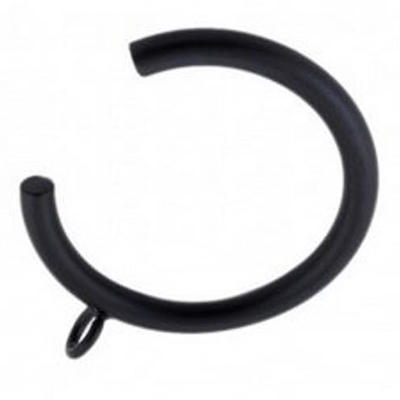
Ahhhh… that’s called a “C ring” for obvious reasons. The one above is from a boutique custom-drapery hardware company on Etsy called Lilly Max Decor.
What’s it for?
It’s for when you have a long decorative bracket that requires more than three brackets.
Normal rings won’t be able to go past the extra brackets. Therefore, some of the rings will need to be able to pass by those two brackets.
Or, sometimes, the curtains might need to open to one side or the other, and there’s one center bracket to contend with.
Can you purchase rings and rods from different places?
Yes, you can. And what if the finish doesn’t match? If it’s already hand-painted, you can adjust the rod a little with some craft paint. But, unless the match is several shades off, it won’t be noticeable. I know this from experience.
Laurel, you haven’t talked about tie-backs.
You’re right. I haven’t. They’re lovely in a grand old home with 10-foot-high floor-to-ceiling windows. But, they’re a bloody pain in the arse. I always did holdbacks instead of ties.
One last question, Laurel, about the drapery hardware
Okay, fire away.
How do you know how high to hang the rod? Or rather, how do you know how long the draperies should be?
Oh, this is such a great question. There is usually some wiggle room, especially if it’s okay with you or your client if the curtains can break on the floor. I said break, not puddle. Nobody does that any longer. By break, I mean at most an inch hitting the floor.
But, this is where it is advisable to know what curtain hardware you’re using before you order your curtains. Once you know that, all you need to do is figure out how high your rod should be and allow space for the rod and rings. It’s usually about the overall diameter of the ring.
So, if your rod is at 92″ off of the floor and you’d like your drapes to break slightly, they should be about 91″ long. If you don’t want the break, then about 90″ should be good. But, always double if not triple-check!
Below is a mini widget with some of the products we’ve discussed and terrific sources for drapery hardware.

Okay, I am quite positive that I have not covered everything.
It’s a surprisingly broad topic!
You might also enjoy this post about different drapery styles shown in 17th – 19th-century art.
But, have you seen these so-called easy-to-install brackets? They don’t put ANY holes in the wall.
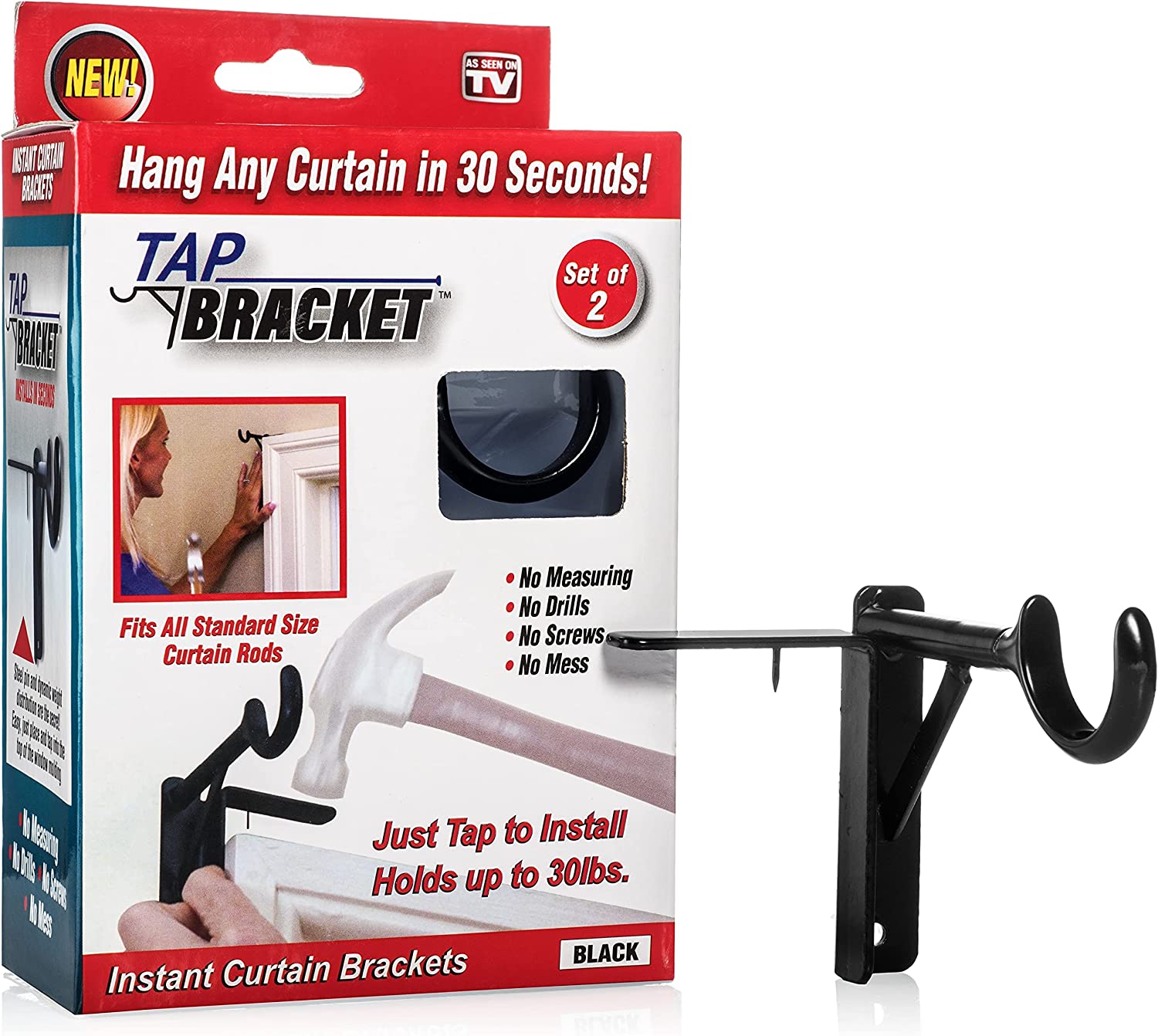
They’re called Tap Bracket. (You can see them here.)
They claim that anyone can hang curtains in 30 seconds or less!
Really?
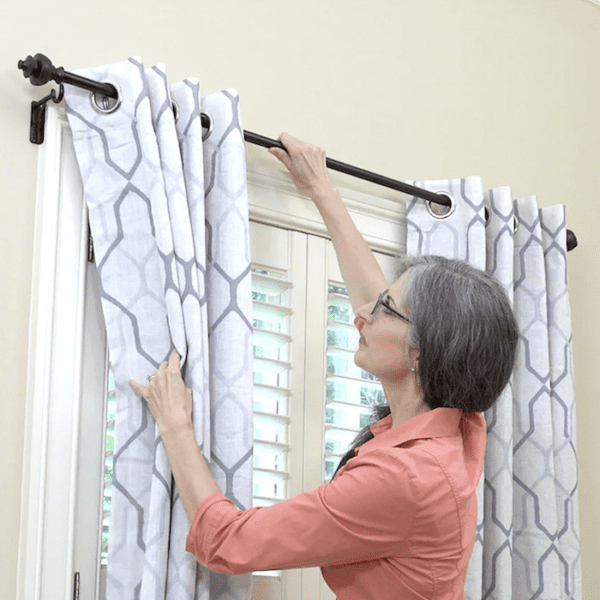
Below is a video that tests them to see if they really work.
Well, I’ll be. I would love to put these up in my new rental. The only problem is that the top of the window moulding is about two inches from the ceiling. I know, very unusual. It would not be easy to get a hammer in there.
Please read about the Best Bay Window Treatments and Measuring Guide.
Okay, gotta finish packing! I hope you enjoyed this post about drapery hardware!
xo,

PS: Please check out the newly updated HOT SALES and the newly updated gift guide for Father’s Day!
Related Posts
 Are Green and White Rooms Trendy or Passé?
Are Green and White Rooms Trendy or Passé? Everything You Need To Know About Classic Woven Wood Blinds
Everything You Need To Know About Classic Woven Wood Blinds 21 Common and Hideous Interior Design Mistakes
21 Common and Hideous Interior Design Mistakes The Horrid Gray Trend – Is It Finally Over?
The Horrid Gray Trend – Is It Finally Over? The Best Upholstery Fabrics For Pets and Slobs
The Best Upholstery Fabrics For Pets and Slobs The Magnificent Front Doors of Beacon Hill
The Magnificent Front Doors of Beacon Hill How To Avoid the Clash of Formal and Casual Furnishings
How To Avoid the Clash of Formal and Casual Furnishings










